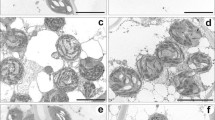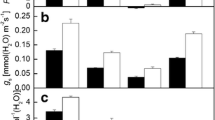Abstract
The differences in some morphological and physiological characteristics of sun- and shade-adapted Haberlea rhodopensis plants were compared. Changes in the photosynthetic activity, electrolyte leakage from leaf tissues, malondialdehyde content (MDA) and leaf anatomy were studied at different degrees of desiccation as well as after rehydration of plants. The MDA content in well-watered sun Haberlea plants was higher compared to shade plants suggesting higher lipid peroxidation, which is commonly regarded as an indicator of oxidative stress, but desiccation of plants at high light did not cause additional oxidative damage as judged by the unaffected MDA content. The electrolyte leakage from dried leaves (8% RWC) from both shade and sun plants increased fourfold indicating similar membrane damage. However, the recovery after rehydration showed that this damage was reversible. Well-watered sun plants had higher photosynthetic activity probably due to the larger thickness of the mesophyll layer in such plants. On the other hand, desiccation at high light reduced CO2 assimilation which was in accordance with the stronger reduction of stomatal conductance. Stomata were visible only on the abaxial side of sun leaves having also higher abundance of non-glandular trichomes. Increased trichomes density and epicuticular waxes and filaments upon desiccation could help plants to increase reflection, reduce net radiation income, slow down the rate of water loss and survive adverse conditions.








Similar content being viewed by others
References
Cooper K, Farrant JM (2002) Recovery of the resurrection plant Craterostigma wilmsii from desiccation: protection vs. repair. J Exp Bot 53:1805–1813
Demmig-Adams B, Adams WW (1996) The role of xanthophylls cycle carotenoids in the protection of photosynthesis. Trends Plant Sci 1:21–26
Esterbauer H, Cheeseman KH (1990) Determination of aldehydic lipid peroxidation products: malonaldehyde and 4-hydroxynonenal. Methods Enzymol 186:407–421
Evans JR, Kaldenhoff R, Genty B, Terashima I (2009) Resistances along the CO2 diffusion pathway inside leaves. J Exp Bot 60:2235–2248
Farrant JM (2000) A comparison of mechanisms of desiccation tolerance among three angiosperm resurrection plant species. Plant Ecol 151:29–39
Farrant GM, Willingen CV, Loffell DA, Bartsch S, Whittaker A (2003) An investigation into the role of light during desiccation of three angiosperm resurrection plants. Plant Cell Environ 26:1275–1286
Farrant JM, Brandt W, Lindsey GG (2007) An overview of mechanisms of desiccation tolerance in selected angiosperm resurrection plants. Plant Stress J 1:72–84
Flexas J, Bota J, Escalona JM, Sampol B, Medrano H (2002) Effects of drought on photosynthesis in grapevines under field conditions: an evaluation of stomatal and mesophyll limitations. Funct Plant Biol 29:461–471
Georgieva K, Maslenkova L (2006) Thermostability and photostability of photosystem II of the resurrection plant Haberlea rhodopensis studied by chlorophyll fluorescence. Z Naturforsh C 61:234–240
Georgieva K, Maslenkova L, Peeva P, Markovska Y, Stefanov D, Tuba Z (2005) Comparative study on the changes in photosynthetic activity of the homoiochlorophyllous desiccation-tolerant Haberlea rhodopensis and desiccation-sensitive spinach leaves during desiccation and rehydration. Photosynth Res 85:191–203
Georgieva K, Szigeti Z, Sarvari E, Gaspar L, Maslenkova L, Peva V, Peli E, Tuba Z (2007) Photosynthetic activity of homoiochlorophyllous desiccation tolerant plant Haberlea rhodopensis during desiccation and rehydration. Planta 225:955–964
Georgieva K, Lenk S, Buschmann C (2008) Responses of the resurrection plant Haberlea rhodopensis to high irradiance. Photosynthetica 46:208–215
Havaux M, Tardy F (1999) Loss of chlorophyll with limited reduction of photosynthesis as an adaptive response of Syrian barley landraces to high-light and heat stress. Aust J Plant Physiol 26:569–578
Lawlor DW, Cornic G (2002) Photosynthetic carbon assimilation and associated metabolism in relation to water deficits in higher plants. Plant Cell Environ 25:275–294
Lichtenthaler KH (1987) Chlorophylls and carotenoids: pigments of photosynthetic biomembranes. Methods Enzymol 148:350–382
Moore JP, Vicre M, Farrant JM, Driouich A (2008) Adaptations of higher plant cell walls to water loss: drought versus desiccation. Physiol Plant 134:237–245
Oliver MJ (1996) Desiccation tolerance in vegetative plant cells. Physiol Plant 97:779–787
Oliver MJ, Velten J, Mischler BD (2005) Desiccation tolerance in bryophytes: a reflection of a primitive strategy for plant survival in dehydrating habitats. Integr Comp Biol 45:788–799
Peeva V, Cornic G (2009) Leaf photosynthesis of Haberlea rhodopensis before and during drought. Environ Exp Bot 65:310–318
Proctor MCF, Pence VC (2002) Vegetative tissues: bryophytes, vascular resurrection plants and vegetative propagules. In: Black M, Pritchard HW (eds) Desiccation and plant survival: drying without dying. CABI Publishing, Wallingford, pp 207–237
Proctor MCF, Smirnoff N (2000) Rapid recovery of photosystems on rewetting desiccation-tolerant mosses: chlorophyll fluorescence and inhibitor experiments. J Exp Bot 51:1695–1704
Proctor MCF, Ligrone R, Duckett JG (2007) Desiccation tolerance in the moss Polytrichum formosum: physiological and fine-structural changes during desiccation and recovery. Ann Bot 99:75–93
Ramanjulu S, Bartels D (2002) Drought- and desiccation induced modulation of gene expression in plants. Plant Cell Environ 25:141–151
Robinson S, Lovelock CE, Osmond CB (1993) Wax as a mechanism for protection against photoinhibition. A study of Cotyledon orbiculata. Bot Acta 106:307–312
Schwab KB, Schreiber U, Heber U (1989) Response of photosynthesis and respiration of resurrection plants to desiccation and rehydration. Planta 177:217–227
Smirnoff N (1993) The role of active oxygen in the response of plants to water deficit and desiccation. New Phytol 125:27–58
Terashima I, Hanba YT, Tazoe Y, Vyas P, Yano S (2006) Irradiance and phenotype: comparative eco-development of sun and shade leaves in relation to photosynthetic CO2 diffusion. J Exp Bot 57:343–354
Vecchia FD, Asmar TE, Calamassi R, Rascio N, Vazzana C (1998) Morphological and ultrastructural aspects of dehydration and rehydration in leaves of Sporobolus stapfianus. Plant Growth Reg 24:219–228
Vicré M, Sherwin HW, Driouich A, Jaffer M, Jauneau A, Farrant JM (1999) Cell wall properties of hydrated and dry leaves of the resurrection plant Craterostigma wilmsii. J Plant Physiol 155:719–726
Vicré M, Farrant JM, Driouich A (2004) Insights into the cellular mechanisms of desiccation tolerance among angiosperm resurrection plant species. Plant Cell Environ 27:1329–1340
von Caemmerer S, Farquhar GD (1981) Some relationships between the biochemistry of photosynthesis and the gas exchange of leaves. Planta 153:376–387
Walters RG (2005) Towards an understanding of photosynthetic acclimation. J Exp Bot 56:435–447
Acknowledgments
This work was supported by the National Science Fund under research project DO02-208/2008.
Author information
Authors and Affiliations
Corresponding author
Rights and permissions
About this article
Cite this article
Georgieva, K., Doncheva, S., Mihailova, G. et al. Response of sun- and shade-adapted plants of Haberlea rhodopensis to desiccation. Plant Growth Regul 67, 121–132 (2012). https://doi.org/10.1007/s10725-012-9669-3
Received:
Accepted:
Published:
Issue Date:
DOI: https://doi.org/10.1007/s10725-012-9669-3




